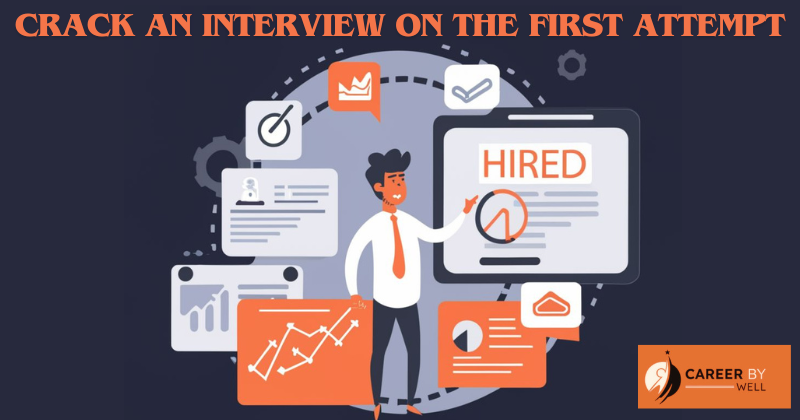Cracking an interview on the first attempt is indeed a common aspiration, there are several strategies you can employ to achieve your goal.
Cracking an interview on the first attempt is a common aspiration. But with the right strategies, you can increase your chances of success. Thorough strategic preparation is key to cracking an interview on your first attempt.
So let’s explore how you can better align yourself to crack an interview on your first attempt and nail it like a pro.
Instead of viewing interviews as mere hurdles to overcome, shift your mindset towards becoming a perfect fit for the role you desire. Don’t just aim to “crack” interviews, aim to genuinely showcase your suitability for the position. To do this effectively, it’s essential to cultivate the following key strategies:
Strategies to Crack an Interview on the First Attempt:
1. Conduct a 360-degree analysis of the company:
Before preparing for a placement interview, conduct a thorough 360-degree analysis of the company you’re targeting. Gather as much information as possible about the organization, its products or services, key personnel such as the CEO and CTO, and the specific job role you’re applying for.
By doing your homework diligently, you’ll be better equipped to handle questions from the recruiter about the company and the role. This demonstrates your genuine interest and commitment to the opportunity, which can significantly enhance your chances of success in the interview.
Gather details such as the company’s year of establishment, its core offerings, and any recent developments or achievements. Additionally, familiarize yourself with the qualifications and certifications required for the job, as this will showcase your preparedness and suitability for the role.
2. Match Yourself with Job Requirements:
You need to match yourself with the job requirements to showcase the skills and experiences that align with the qualifications outlined in the job description.
Thoroughly review the job posting to understand the role’s responsibilities and desired attributes. Identify your strengths and highlight relevant experiences that demonstrate your ability to meet the job requirements.
Tailor your application materials to emphasize these qualifications, using keywords from the job description to optimize for applicant tracking systems. Prepare for interviews by anticipating questions related to the job requirements and showcasing specific examples of how your experiences align with the needs of the position.
Additionally, highlight transferable skills and demonstrate enthusiasm for the role and willingness to learn and grow within the organization. Seeking feedback from mentors and peers can further refine your approach, increasing your chances of successfully matching yourself with job opportunities.
Conducting a comprehensive analysis beforehand not only strengthens your understanding of the company but also reinforces your credibility and seriousness as a candidate, increasing your likelihood of securing the position.
3. Build a Portfolio:
Building a portfolio for an interview requires selecting relevant projects that highlight your strengths and align with the job requirements.
Clearly outline your contributions to each project, providing context, and quantifying your achievements where possible. Showcase a variety of skills and experiences through diverse projects, organized professionally with clear headings and visually appealing design elements.
Include visuals and multimedia to illustrate your work effectively and keep your portfolio updated with new projects and experiences. Seek feedback from peers and mentors, and practice presenting your portfolio confidently during interviews.
4. Solid Foundational Knowledge:
Ensure you possess a strong understanding of the foundational concepts relevant to your field. This forms the bedrock upon which you can build your expertise.
During an interview, it’s crucial to demonstrate solid foundational knowledge effectively. Answer questions confidently, provide concrete examples, and explain concepts clearly. Showcase problem-solving skills, highlight relevant expertise, and ask thoughtful questions. Stay engaged, adapt to different formats, and leave a positive impression.
5. Show Your Cultural Fit:
To show that you’re a perfect fit for the company culture, pay attention to the company’s values and strive to align yourself with them. Showing that you are a good fit for a company culture during an interview is essential for both the interviewer to assess your suitability and for you to determine if the company aligns with your values and working style.
Emphasize values that match the company’s, highlight instances of aligning with these values in past experiences, and use anecdotes to demonstrate qualities valued by the company. Show how you’ve embodied these qualities in teamwork, leadership, adaptability, etc.
Inquire about team dynamics, collaboration, and professional development opportunities. Show interest in understanding and fitting into the company culture. Express genuine excitement for the company’s mission, products, and achievements. Convey enthusiasm throughout the interview and leave a lasting impression.
Dress To Impress:
Dressing appropriately for an interview is crucial, as it helps create a positive first impression. Here’s how to dress for different types of interviews:
-
Formal/Corporate Interview:
- Men: Wear a dark-coloured suit (navy or charcoal) with a white or light-coloured dress shirt.
- Women: Opt for a tailored suit or a conservative dress with a blazer.
- Both: Pair with closed-toe dress shoes in black or brown and minimal accessories.
-
Business Casual Interview:
- Men: Choose dress slacks or chinos with a button-down shirt or a polo shirt. You can skip the tie.
- Women: Wear a blouse or a sweater with dress slacks or a knee-length skirt. You can add a blazer for a more polished look.
- Both: Stick to closed-toe shoes, such as loafers or flats, and keep accessories minimal.
-
Creative/Startup Interview:
- Men: Opt for smart-casual attire, such as tailored trousers with a button-down shirt or a casual blazer.
- Women: Choose a stylish blouse with dress pants or a skirt, or a fashionable dress with a cardigan or jacket.
- Both: Add personal flair with unique accessories or trendy footwear, but avoid anything too casual or flashy.
-
Remote/Video Interview:
- Dress professionally from head to toe, even if you’re only visible from the waist up.
- Avoid loud patterns or distracting jewellery that may not translate well on camera.
- Opt for solid colours and well-fitted attire to convey professionalism.
-
Research the Company Culture:
- Consider the company’s dress code and industry norms when selecting your interview outfit.
- If in doubt, it’s generally better to overdress slightly than to underdress for an interview.
-
Personal Grooming:
- Ensure that your clothes are clean, pressed, and free of wrinkles or stains.
- Style your hair neatly and maintain a well-groomed appearance.
- Avoid heavy cologne or perfume, as strong scents can be off-putting.
-
Comfort and Confidence:
- Choose clothing that makes you feel comfortable and confident, as this will help you perform your best during the interview.
- Practice good posture and maintain eye contact to convey professionalism and self-assurance.
D0’s and Don’t Of Interview:
These Do’s and Don’ts can help candidates navigate the interview process effectively and make a positive impression on the interviewer. By keeping these in mind you are increasing your chances of cracking an interview on the first attempt.
| Do’s | Don’ts |
|---|---|
| Research the company and the role thoroughly. | Don’t arrive late or unprepared. |
| Dress appropriately for the company culture. | Don’t dress too casually or too formally without |
| considering the company’s dress code. | |
| Practice answering common interview questions. | Don’t speak negatively about past employers or experiences. |
| Prepare questions to ask the interviewer. | Don’t interrupt the interviewer or monopolize the conversation. |
| Maintain good posture and positive body language. | Don’t slouch, fidget, or appear disinterested. |
| Listen actively to the interviewer’s questions. | Don’t answer questions with vague or irrelevant responses. |
| Provide specific examples to support your answers. | Don’t exaggerate or lie about your qualifications or experiences. |
| Express enthusiasm and interest in the role. | Don’t appear arrogant or overly confident. |
| Follow up with a thank-you email after the interview. | Don’t forget to follow up or express appreciation for the opportunity. |
| Stay calm and composed throughout the interview. | Don’t let nerves or stress overwhelm you. |
Final Thoughts:
By focusing on these areas, you’ll not only enhance your interview performance but also increase your chances of securing the job you desire. Remember, interview success is about more than just cracking a code – it’s about showcasing your genuine value and fit for the role and the company.
By implementing these strategies and thoroughly preparing for your interview, you can increase your chances of cracking an interview on the first attempt. Remember that each interview is a learning experience, regardless of the outcome, and strive to continuously improve your skills for future opportunities.

